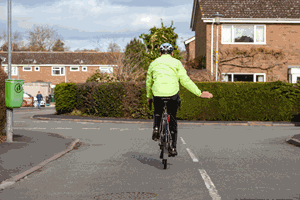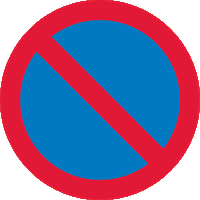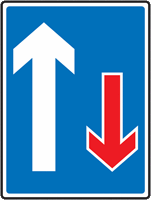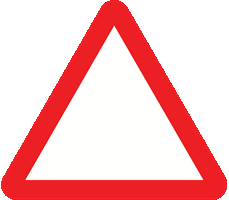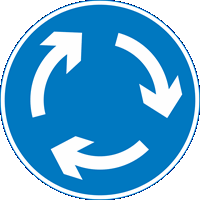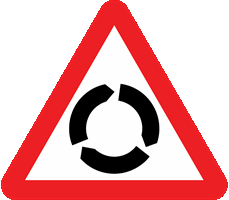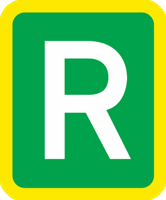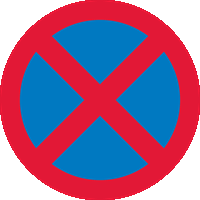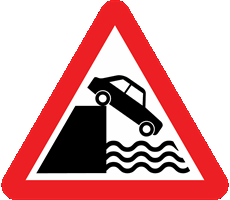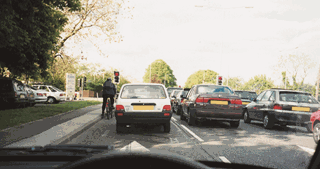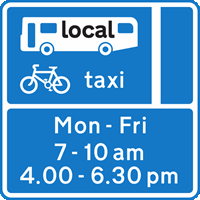You have 57 minutes to answer 50 multiple choice driving theory test questions. You need to answer at least 43 out of 50 questions correctly to pass. You can review your answer after each question or you can review all of your answers at the end of the test. Best of luck!
Test Quick View
Click on an answer to view the correct choice along with the explanation.
1. A long, heavily laden lorry is taking a long time to overtake you. What should you do? Mark one answer
AB
C
D
Correct Answer: C
Explanation: A long lorry with a heavy load will need more time to pass you than a car, especially on an uphill stretch of road. Slow down and allow the lorry to pass.
Explanation: A long lorry with a heavy load will need more time to pass you than a car, especially on an uphill stretch of road. Slow down and allow the lorry to pass.
Correct Answer: D
Explanation: Keep well back and give the cyclist time and room to turn safely. Don't intimidate them by getting too close or trying to squeeze past.
Explanation: Keep well back and give the cyclist time and room to turn safely. Don't intimidate them by getting too close or trying to squeeze past.
3. You're turning left at a junction where pedestrians have started to cross. What should you do? Mark one answer
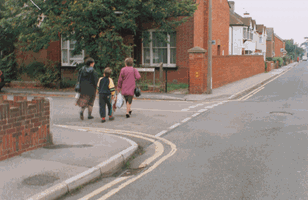
B
C
D
Correct Answer: A
Explanation: When you're turning into a side road, pedestrians who are crossing have priority. You should wait to allow them to finish crossing safely. Be patient if they're slow or unsteady. Don't try to rush them by sounding your horn, flashing your lights, revving your engine or giving any other inappropriate signal.
Explanation: When you're turning into a side road, pedestrians who are crossing have priority. You should wait to allow them to finish crossing safely. Be patient if they're slow or unsteady. Don't try to rush them by sounding your horn, flashing your lights, revving your engine or giving any other inappropriate signal.
4. You're travelling in very heavy rain. How is this likely to affect your overall stopping distance? Mark one answer
AB
C
D
Correct Answer: A
Explanation: The road will be very wet and spray from other vehicles will reduce your visibility. Tyre grip will also be reduced, increasing your stopping distance. You should at least double your separation distance.
Explanation: The road will be very wet and spray from other vehicles will reduce your visibility. Tyre grip will also be reduced, increasing your stopping distance. You should at least double your separation distance.
Correct Answer: B
Explanation: Red rear reflectors show up when headlights shine on them. These are useful when you're parked at night, but they'll only reflect if you park in the same direction as the traffic flow. Normally you should park on the left, but in a one-way street you may also park on the right-hand side.
Explanation: Red rear reflectors show up when headlights shine on them. These are useful when you're parked at night, but they'll only reflect if you park in the same direction as the traffic flow. Normally you should park on the left, but in a one-way street you may also park on the right-hand side.
Correct Answer: D
Explanation: There'll be a plate or additional sign to tell you when the restrictions apply.
Explanation: There'll be a plate or additional sign to tell you when the restrictions apply.
Correct Answer: D
Explanation: Don't force your way through. Show courtesy and consideration to other road users. Although you have priority, make sure oncoming traffic is going to give way before you continue.
Explanation: Don't force your way through. Show courtesy and consideration to other road users. Although you have priority, make sure oncoming traffic is going to give way before you continue.
Correct Answer: C
Explanation: It will take up to ten times longer to stop when it's icy. Where there's a risk of icy conditions, you need to be aware of this and take extra care. If you think the road may be icy, don't brake or steer harshly, as your tyres could lose their grip on the road.
Explanation: It will take up to ten times longer to stop when it's icy. Where there's a risk of icy conditions, you need to be aware of this and take extra care. If you think the road may be icy, don't brake or steer harshly, as your tyres could lose their grip on the road.
Correct Answer: D
Explanation: Warning signs are there to make you aware of potential hazards on the road ahead. Take note of the signs so you're prepared and can take whatever action is necessary.
Explanation: Warning signs are there to make you aware of potential hazards on the road ahead. Take note of the signs so you're prepared and can take whatever action is necessary.
Correct Answer: C
Explanation: Ring roads are designed to relieve congestion in towns and city centres.
Explanation: Ring roads are designed to relieve congestion in towns and city centres.
11. You're at a junction controlled by traffic lights. When shouldn't you proceed at green? Mark one answer

B
C
D
Correct Answer: D
Explanation: As you approach the lights, look into the road you wish to take. Only proceed if your exit road is clear. If the road is blocked, hold back, even if you have to wait for the next green signal.
Explanation: As you approach the lights, look into the road you wish to take. Only proceed if your exit road is clear. If the road is blocked, hold back, even if you have to wait for the next green signal.
Correct Answer: C
Explanation: Traffic-calming measures make the roads safer for vulnerable road users, such as cyclists, pedestrians and children. These can be designed as chicanes, road humps or other obstacles that encourage drivers and riders to slow down.
Explanation: Traffic-calming measures make the roads safer for vulnerable road users, such as cyclists, pedestrians and children. These can be designed as chicanes, road humps or other obstacles that encourage drivers and riders to slow down.
13. You're on a country road. What should you expect to see coming towards you on your side of the road? Mark one answer
AB
C
D
Correct Answer: D
Explanation: On a quiet country road, always be aware that there may be a hazard just around the next bend, such as a slow-moving vehicle or pedestrians. Pedestrians are advised to walk on the right-hand side of the road if there's no pavement, so they may be walking towards you on your side of the road.
Explanation: On a quiet country road, always be aware that there may be a hazard just around the next bend, such as a slow-moving vehicle or pedestrians. Pedestrians are advised to walk on the right-hand side of the road if there's no pavement, so they may be walking towards you on your side of the road.
Correct Answer: C
Explanation: Take care if you have to pass a parked vehicle on your side of the road. Give way to oncoming traffic if there isn't enough room for you both to continue safely.
Explanation: Take care if you have to pass a parked vehicle on your side of the road. Give way to oncoming traffic if there isn't enough room for you both to continue safely.
15. You're driving at the legal speed limit. A vehicle comes up quickly behind you, flashing its headlights. What should you do? Mark one answer
AB
C
D
Correct Answer: B
Explanation: Don't enforce the speed limit by blocking another vehicle's progress. This will only lead to the other driver becoming more frustrated. Allow the other vehicle to pass when you can do so safely.
Explanation: Don't enforce the speed limit by blocking another vehicle's progress. This will only lead to the other driver becoming more frustrated. Allow the other vehicle to pass when you can do so safely.
Correct Answer: A
Explanation: Don't park within 10 metres (32 feet) of a junction (unless in an authorised parking place). This is to allow drivers emerging from, or turning into, the junction a clear view of the road they're joining. It also allows them to see hazards such as pedestrians or cyclists at the junction.
Explanation: Don't park within 10 metres (32 feet) of a junction (unless in an authorised parking place). This is to allow drivers emerging from, or turning into, the junction a clear view of the road they're joining. It also allows them to see hazards such as pedestrians or cyclists at the junction.
Correct Answer: A
Explanation: You should be careful in these locations, as the road surface is likely to be wet and slippery. There may be a steep drop to the water, and there may not be a barrier along the edge of the road.
Explanation: You should be careful in these locations, as the road surface is likely to be wet and slippery. There may be a steep drop to the water, and there may not be a barrier along the edge of the road.
18. Why can it be an advantage for traffic speed to stay constant over a longer distance? Mark one answer
AB
C
D
Correct Answer: D
Explanation: When traffic travels at a constant speed over a longer distance, journey times normally improve. You may feel that you could travel faster for short periods, but this generally leads to bunching and increased overall journey time.
Explanation: When traffic travels at a constant speed over a longer distance, journey times normally improve. You may feel that you could travel faster for short periods, but this generally leads to bunching and increased overall journey time.
19. You're waiting to turn right at the end of a road. Your view is obstructed by parked vehicles. What should you do? Mark one answer
AB
C
D
Correct Answer: B
Explanation: At junctions, your view is often restricted by buildings, trees or parked cars. You need to be able to see in order to judge a safe gap. Edge forward slowly and keep looking all the time. Don't cause other road users to change speed or direction as you emerge.
Explanation: At junctions, your view is often restricted by buildings, trees or parked cars. You need to be able to see in order to judge a safe gap. Edge forward slowly and keep looking all the time. Don't cause other road users to change speed or direction as you emerge.
20. A police officer asks to see your documents. You don't have them with you. Within what time must you produce them at a police station? Mark one answer
AB
C
D
Correct Answer: D
Explanation: You don't have to carry around your vehicle's documents wherever you go. If a police officer asks to see them and you don't have them with you, you may be asked to produce them at a police station within 7 days.
Explanation: You don't have to carry around your vehicle's documents wherever you go. If a police officer asks to see them and you don't have them with you, you may be asked to produce them at a police station within 7 days.
Correct Answer: A
Explanation: Remember this procedure by saying DR ABC. This stands for Danger, Response, Airway, Breathing, Compressions. Give whatever first aid you can and stay with the injured person until the emergency services arrive.
Explanation: Remember this procedure by saying DR ABC. This stands for Danger, Response, Airway, Breathing, Compressions. Give whatever first aid you can and stay with the injured person until the emergency services arrive.
22. You're driving behind a large goods vehicle. What should you do if it signals left but steers to the right? Mark one answer
AB
C
D
Correct Answer: D
Explanation: Large, long vehicles need extra room when making turns at junctions. They may move out to the right in order to make a left turn. Keep well back and don't attempt to pass them on their left.
Explanation: Large, long vehicles need extra room when making turns at junctions. They may move out to the right in order to make a left turn. Keep well back and don't attempt to pass them on their left.
23. You're waiting in a traffic queue at night. How can you avoid dazzling drivers behind you? Mark one answer
AB
C
D
Correct Answer: C
Explanation: In queuing traffic, your brake lights can dazzle drivers behind you. If you apply your parking brake, you can take your foot off the footbrake. This will deactivate the brake lights.
Explanation: In queuing traffic, your brake lights can dazzle drivers behind you. If you apply your parking brake, you can take your foot off the footbrake. This will deactivate the brake lights.
24. You're driving in traffic at the speed limit for the road. What should you do if the driver behind is trying to overtake? Mark one answer
AB
C
D
Correct Answer: B
Explanation: Keep a steady course to give the driver behind an opportunity to overtake safely. If necessary, slow down. Reacting incorrectly to another driver's impatience can lead to danger.
Explanation: Keep a steady course to give the driver behind an opportunity to overtake safely. If necessary, slow down. Reacting incorrectly to another driver's impatience can lead to danger.
Correct Answer: C
Explanation: If someone in charge of animals asks you to stop, you should do so and switch off your engine. Animals are unpredictable and startle easily; they could turn and run into your path or into the path of another moving vehicle.
Explanation: If someone in charge of animals asks you to stop, you should do so and switch off your engine. Animals are unpredictable and startle easily; they could turn and run into your path or into the path of another moving vehicle.
Correct Answer: A
Explanation: A roof rack increases your car's wind resistance. This will cause an increase in fuel consumption, so you should remove it when it isn't being used. An aerodynamically designed roof rack or box will help reduce wind resistance to a minimum, but the rack or box should still be removed when it isn't in use.
Explanation: A roof rack increases your car's wind resistance. This will cause an increase in fuel consumption, so you should remove it when it isn't being used. An aerodynamically designed roof rack or box will help reduce wind resistance to a minimum, but the rack or box should still be removed when it isn't in use.
27. What should you clear of ice and snow before starting a journey in freezing weather? Mark one answer
AB
C
D
Correct Answer: D
Explanation: Driving in bad weather increases your risk of having a collision. If you absolutely have to travel, clear your lights, mirrors, number plates and windows of any snow or ice, so that you can see and be seen.
Explanation: Driving in bad weather increases your risk of having a collision. If you absolutely have to travel, clear your lights, mirrors, number plates and windows of any snow or ice, so that you can see and be seen.
Correct Answer: A
Explanation: By driving all four wheels, the vehicle has maximum grip on the road. This grip is especially helpful when travelling on slippery or uneven surfaces. However, having four-wheel drive doesn't replace the skills you need to drive safely.
Explanation: By driving all four wheels, the vehicle has maximum grip on the road. This grip is especially helpful when travelling on slippery or uneven surfaces. However, having four-wheel drive doesn't replace the skills you need to drive safely.
29. You're driving towards this level crossing. What would be the first warning of an approaching train? Mark one answer
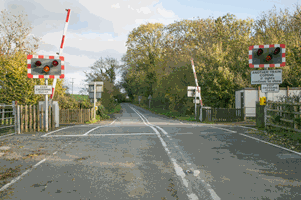
B
C
D
Correct Answer: A
Explanation: The steady amber light will be followed by twin flashing red lights that mean you must stop. An alarm will also sound to alert you to the fact that a train is approaching.
Explanation: The steady amber light will be followed by twin flashing red lights that mean you must stop. An alarm will also sound to alert you to the fact that a train is approaching.
Correct Answer: D
Explanation: If you're waiting at traffic lights, check all around you before you move away, as cyclists often filter through waiting traffic. Allow the cyclist to move off safely.
Explanation: If you're waiting at traffic lights, check all around you before you move away, as cyclists often filter through waiting traffic. Allow the cyclist to move off safely.
31. You want to reverse into a side road, but you aren't sure that the area behind your car is clear. What should you do? Mark one answer
AB
C
D
Correct Answer: C
Explanation: If you can't tell whether there's anything behind you, it's always safest to check before reversing. There may be a small child or a low obstruction close behind your car.
Explanation: If you can't tell whether there's anything behind you, it's always safest to check before reversing. There may be a small child or a low obstruction close behind your car.
32. You're driving in a slow-moving queue of traffic. Just before changing lane, what should you do? Mark one answer
AB
C
D
Correct Answer: C
Explanation: In queuing traffic, motorcyclists could be passing you on either side. Use your mirrors and check your blind area before changing lanes or changing direction.
Explanation: In queuing traffic, motorcyclists could be passing you on either side. Use your mirrors and check your blind area before changing lanes or changing direction.
33. You're driving in town. There's a bus at the bus stop on the other side of the road. Why should you be careful? Mark one answer
AB
C
D
Correct Answer: A
Explanation: If you see a bus ahead, watch out for pedestrians. They might not be able to see you if they're crossing from behind the bus.
Explanation: If you see a bus ahead, watch out for pedestrians. They might not be able to see you if they're crossing from behind the bus.
34. What's the speed limit for a car towing a small caravan along a dual carriageway? Mark one answer
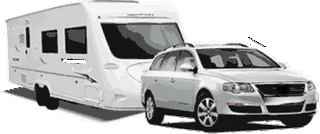
B
C
D
Correct Answer: C
Explanation: The speed limit for cars towing caravans or trailers on dual carriageways or motorways is 60 mph. Due to the increased weight and size of the combination, you should plan further ahead. Take care in windy weather, as a strong side wind can make a caravan or large trailer unstable.
Explanation: The speed limit for cars towing caravans or trailers on dual carriageways or motorways is 60 mph. Due to the increased weight and size of the combination, you should plan further ahead. Take care in windy weather, as a strong side wind can make a caravan or large trailer unstable.
35. You're waiting at a T-junction. A vehicle is coming from the right, with its left indicator flashing. What should you do? Mark one answer
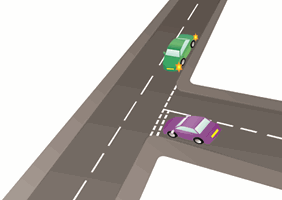
B
C
D
Correct Answer: D
Explanation: Other road users may give misleading signals. When you're waiting at a junction, don't emerge until you're sure of their intentions.
Explanation: Other road users may give misleading signals. When you're waiting at a junction, don't emerge until you're sure of their intentions.
36. You're driving with your front fog lights switched on. Earlier fog has now cleared. What should you do? Mark one answer
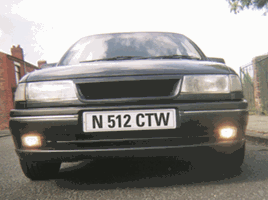
B
C
D
Correct Answer: D
Explanation: Switch off your fog lights if the weather improves, but be prepared to use them again if visibility reduces to less than 100 metres (328 feet).
Explanation: Switch off your fog lights if the weather improves, but be prepared to use them again if visibility reduces to less than 100 metres (328 feet).
Correct Answer: A
Explanation: Looking at road maps while driving is very dangerous. If you aren't sure of your route, stop in a safe place and check the map. You must not allow anything to take your attention away from the road while you're driving.
Explanation: Looking at road maps while driving is very dangerous. If you aren't sure of your route, stop in a safe place and check the map. You must not allow anything to take your attention away from the road while you're driving.
Correct Answer: C
Explanation: It's your responsibility to make sure you're properly insured for the vehicle you're driving. This is the case regardless of whether you're a newly qualified driver or one with more experience.
Explanation: It's your responsibility to make sure you're properly insured for the vehicle you're driving. This is the case regardless of whether you're a newly qualified driver or one with more experience.
Correct Answer: A
Explanation: By looking well ahead and recognising hazards in good time, you can avoid late and heavy braking. Watch the traffic flow and look well ahead for potential hazards so you can control your speed in good time. Avoid over-revving the engine and accelerating harshly, as this increases wear to the engine and uses more fuel.
Explanation: By looking well ahead and recognising hazards in good time, you can avoid late and heavy braking. Watch the traffic flow and look well ahead for potential hazards so you can control your speed in good time. Avoid over-revving the engine and accelerating harshly, as this increases wear to the engine and uses more fuel.
40. You're on a road that's only wide enough for one vehicle. A car is coming towards you. What should you do? Mark one answer
AB
C
D
Correct Answer: C
Explanation: Pull into the nearest passing place on the left if you meet another vehicle on a narrow road. If the nearest passing place is on the right, wait opposite it.
Explanation: Pull into the nearest passing place on the left if you meet another vehicle on a narrow road. If the nearest passing place is on the right, wait opposite it.
41. You're approaching a red light at a puffin crossing. Pedestrians are on the crossing. When will the red light change? Mark one answer
AB
C
D
Correct Answer: B
Explanation: A sensor will automatically detect that the pedestrians have reached a safe position. Don't drive on until the green light shows and it's safe for you to do so.
Explanation: A sensor will automatically detect that the pedestrians have reached a safe position. Don't drive on until the green light shows and it's safe for you to do so.
Correct Answer: A
Explanation: Some bus lanes operate only during peak hours and other vehicles may use them outside these hours. Make sure you check the sign for the hours of operation before driving in a bus lane.
Explanation: Some bus lanes operate only during peak hours and other vehicles may use them outside these hours. Make sure you check the sign for the hours of operation before driving in a bus lane.
43. You're waiting to emerge from a junction. The windscreen pillar is restricting your view. What should you be particularly aware of? Mark one answer
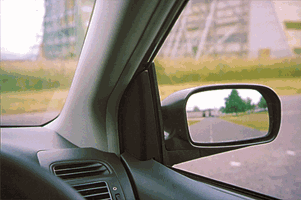
B
C
D
Correct Answer: D
Explanation: Windscreen pillars can completely block your view of pedestrians, motorcyclists and cyclists. You should make a particular effort to look for these road users; don't just rely on a quick glance.
Explanation: Windscreen pillars can completely block your view of pedestrians, motorcyclists and cyclists. You should make a particular effort to look for these road users; don't just rely on a quick glance.
44. You've just driven out of fog. What must you do now that visibility has improved? Mark one answer
AB
C
D
Correct Answer: D
Explanation: You must turn off your fog lights if visibility is more than 100 metres (328 feet). Be prepared for the fact that the fog may be patchy and you may need to turn them on again if the fog returns.
Explanation: You must turn off your fog lights if visibility is more than 100 metres (328 feet). Be prepared for the fact that the fog may be patchy and you may need to turn them on again if the fog returns.
45. You're parked in a busy high street. What's the safest way to turn your vehicle around so you can go the opposite way? Mark one answer
AB
C
D
Correct Answer: C
Explanation: Make sure you carry out the manoeuvre without causing a hazard to other vehicles. Choose a place to turn that's safe and convenient for you and for other road users.
Explanation: Make sure you carry out the manoeuvre without causing a hazard to other vehicles. Choose a place to turn that's safe and convenient for you and for other road users.
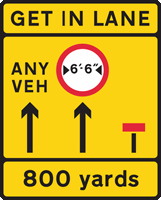
B
C
D
Correct Answer: C
Explanation: Keep a lookout for traffic signs. If you're directed to change lanes, do so in good time. Don't
- push your way into traffic in another lane
- try to gain advantage by delaying changing lanes
Explanation: Keep a lookout for traffic signs. If you're directed to change lanes, do so in good time. Don't
- push your way into traffic in another lane
- try to gain advantage by delaying changing lanes
47. A trailer must stay securely hitched to the towing vehicle. What additional safety device must be fitted to a trailer braking system? Mark one answer
AB
C
D
Correct Answer: A
Explanation: In the event that the trailer becomes detached from the towing vehicle, the breakaway cable activates the trailer brakes before snapping. This allows the towing vehicle to get free of the trailer and out of danger.
Explanation: In the event that the trailer becomes detached from the towing vehicle, the breakaway cable activates the trailer brakes before snapping. This allows the towing vehicle to get free of the trailer and out of danger.
48. You wish to tow a trailer. Where would you find the maximum noseweight allowed on your vehicle's tow hitch? Mark one answer
AB
C
D
Correct Answer: B
Explanation: You must know how to load your trailer or caravan so that the hitch exerts an appropriate downward force on the tow ball. Information about the maximum permitted noseweight can be found in your vehicle handbook or obtained from your vehicle manufacturer's agent.
Explanation: You must know how to load your trailer or caravan so that the hitch exerts an appropriate downward force on the tow ball. Information about the maximum permitted noseweight can be found in your vehicle handbook or obtained from your vehicle manufacturer's agent.
Correct Answer: D
Explanation: Try to look ahead and read the road. Plan your approach to junctions and select the correct gear in good time. This will give you the control you need to deal with any hazards that occur. You'll coast a little every time you change gear. This can't be avoided, but it should be kept to a minimum.
Explanation: Try to look ahead and read the road. Plan your approach to junctions and select the correct gear in good time. This will give you the control you need to deal with any hazards that occur. You'll coast a little every time you change gear. This can't be avoided, but it should be kept to a minimum.
50. You're driving on a road that has a cycle lane. The lane is marked by a broken white line. What does this mean? Mark one answer
AB
C
D
Correct Answer: D
Explanation: Cycle lanes are marked with either a solid or a broken white line. If the line is solid, you should check the times of operation shown on the signs, and not drive or park in the lane during those times. If the line is broken, you shouldn't drive or park in the lane unless it's unavoidable.
Explanation: Cycle lanes are marked with either a solid or a broken white line. If the line is solid, you should check the times of operation shown on the signs, and not drive or park in the lane during those times. If the line is broken, you shouldn't drive or park in the lane unless it's unavoidable.



